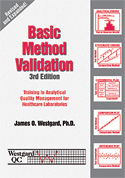Method Validation
Method Validation: The Inner, Hidden, Deeper, Secret Meaning
We run controls, we collect data, we create graphs and charts and plots and crunch numbers. Then we stuff it all in a folder and hand it to an inspector. It's called method validation. But what is it? How do we do it? Why do we do it? Dr. Westgard reveals the secret meaning behind it all. (Preview)
When I was a freshman in college, I had an English professor who taught me something I've never forgotten. He always asked "what's the inner, hidden, deeper, secret meaning" in what you're writing. What are you really trying to accomplish? You'd better figure it out if you expect someone else to understand it. Sure, you can write something, but you've really got to be clear on what you want to accomplish, otherwise the real purpose and meaning will remain a secret.
The real surprise came on my first job as a clinical chemist when I began evaluating the performance of a new multichannel chemistry analyzer. I studied all the existing scientific literature that provided guidelines for performing method validation (MV) studies, but it wasn't at all clear how to tell whether or not a new method was acceptable. No one was telling the secret! And that secret is of paramount importance to evaluate a method properly. Sure, you can collect some data, calculate some statistics, and provide some paper in a folder to show a lab inspector, but is that really why you're doing this?
While I won't claim my english professor made me a better writer (nor can you blame him), he did make me a better scientist by helping me search for the deeper meaning and real purpose in what I do. What's the real purpose of method validation? What's the problem we're trying to solve? Does the present practice provide a correct solution? Is there a better way to do this? How do you know what's the right way to validate the performance of a method?
The Secret Revealed
Here's the inner, hidden, deeper, secret meaning of method validation - and you don't have to read any further to get the message - ERROR ASSESSMENT. You want to estimate how much error might be present in a test result produced by a method in your laboratory. With this information, you then want to be sure that amount of error won't affect the interpretation of the test result and compromise patient care. If your observed errors are so large they can cause an incorrect interpretation, the method isn't accceptable. To be acceptable, the observed errors need to be small relative to changes that will cause a change in the interpretation of a test result.
A focus on analytical errors is the key to the whole method validation process. What kinds of analytical errors might occur with a laboratory method? What experiments can provide data about those errors? What's the best way to perform those experiments to assess the errors? How much data needs to be collected to obtain good estimates of errors? What statistics best estimate the size of those errors from the experimental data? What size errors are allowable without affecting the interpretation of a test and compromising patient care?
Method validation is about error assessment - that's the secret!
We invite you to read the rest of this article.
This article, plus many more important, updated, and expanded chapters are available in the Basic Method Validation manual, 3rd Edition which is available at our online store. You can download the Table of Contents and other chapters here. You can also enroll in the Basic Method Validation course and access the new materials online.

